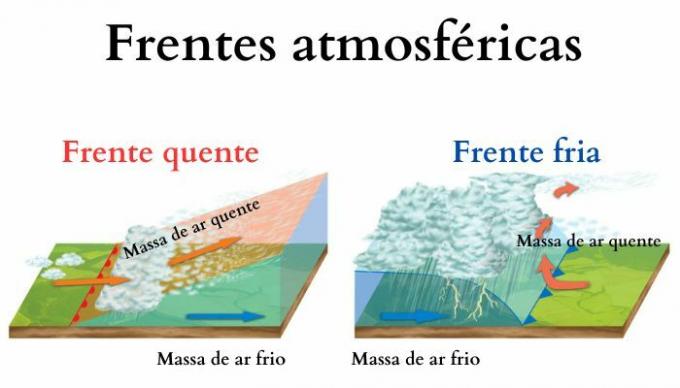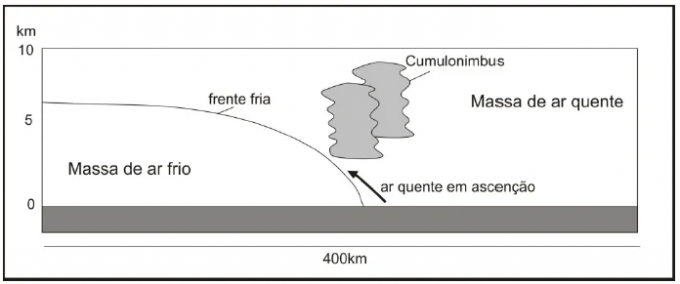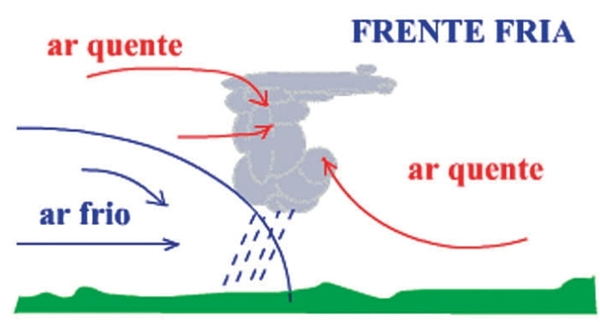Cold front is the name given to the surface formed in the contact between a mass of cold air and a mass of warm air. In this specific case, the front is formed when the colder mass advances over an area where a hot mass is installed, pushing it and promoting significant changes in time atmospheric.
The arrival of a cold front is characterized by the formation of storm clouds, the cumulonimbus, and by the change in wind direction. With the passage of the cold front, there are records of frontal rains, intense winds and temperature drop. The installation of the cold air mass, which happens shortly after the passage of the cold front, is marked by low temperatures, a drop in air humidity and an increase in atmospheric pressure.
Read too: What are the air masses that influence Brazil?
Topics of this article
- 1 - Summary on cold front
- 2 - What is a cold front?
- 3 - When and how does a cold front occur?
- 4 - Characteristics of the cold front
- 5 - Effects of the cold front on the weather
- 6 - Duration of a cold front
- 7 - Differences between cold front and warm front
- 8 - Solved exercises on cold front
Cold front summary
A cold front is the contact surface between air masses of opposite characteristics, always forming when the cold air mass advances over an area where a warm air mass is installed.
The arrival of a cold front causes changes in the atmospheric weather of a region.
Its passage results in a change in the direction of the winds, a drop in temperature and air humidity, an increase in cloudiness and the occurrence of frontal rains.
On cold fronts, The clouds formed are the cumulonimbus, characterized by causing storms and hailstorms.
A cold front can last a few hours or a few days. It all depends on how fast the cold air mass is moving.
While in the cold front the mass of cold air advances over a mass of warm air; In a warm front, a warm air mass advances over a cold air mass.
What is a cold front?
Cold front is the contact surface formed when a cold air massThe moves over a warm air mass. In meteorology and climatology, a front is defined as the surface that marks the transition or meeting between two air masses with different characteristics, such as a warm air mass and a cold air mass, so that a front is formed when the advance of one mass over the other happens, considering that they do not unite.
Do not stop now... There's more after the publicity ;)
When and how does a cold front occur?
a cold front occurs whenever a cold air mass advances over an area where a warm air mass is installed. Thus, the passage of a cold front indicates the change of weather and the installation of a cold air mass, with the retreat of the warm air mass.
Thinking about the Brazilian territory, it is very common to hear about the formation of a cold front when the Atlantic Polar Mass, or mPa, advances through the south of the country and follows its path towards the other regions. The mPa is a cold air mass because it forms in one of the coldest regions from planet Earth, in addition to being humid for developing over the atlantic ocean. The arrival of mPa is much more common in the winter months, when cold fronts are more frequent. However, the formation of cold fronts is recorded at other times of the year as well.
Cold air is denser than warm air, so cold air masses move into the lower layers. of the atmosphere. In the encounter with a layer of warm air, the cold mass continues its journey through the lower part, closer to the surface.xabove the ground, while the warm air mass rises. The contact surface between them is the cold front.
Features of the cold front
The cold front is the contact between a cold air mass and a warm mass. She is responsible for introducing weather changes in the areas through which it advances, and can be easily identified based on the drop in temperatures and the intensification of cloudiness. Where the front is positioned, the formation of many high clouds cumulateOnimbus, also called storm clouds. These clouds form because the warm air is pushed by the cold air and, being less dense, it rises and condenses.
All frontal systems are marked by the occurrence the rains front, which happen whenever two distinct air masses meet. In the cold fronts, the frontal rains are more intense and voluminous, with the chance of hail (type of precipitation in the form of ice).
This type of front tends to move very quickly and can cover a very large area. This means that the passage of a cold front involves several locations at the same time, bringing with it insAtmospheric stability and bad weather.
Effects of the cold front on the weather
The approach of a cold front causes significant changesicaptives in weather. It is very important to remember that the local climate does not suffer any impact, considering that the weather of an area is the average state of the atmosphere over a period of three decades. The arrival of a cold front promotes short-term changes. We can divide the effects of the cold front in time into three stages:
Approaching cold front: the winds get stronger and tend to change direction. Temperatures also get higher, and atmospheric pressure becomes lower. As the cold front advances, cloudiness intensifies.
During the cold front: temperatures drop suddenly, and winds become more intense and frequent. the big clouds cumulonimbus cause heavy rains, with the possibility of hail and the occurrence of storms.
After the passage of the cold front: cloud cover decreases as the cold front dissipates and the cold air mass settles in. At this stage, the clouds present are flatter and have smaller dimensions. Atmospheric pressure increases, and the winds change direction once more. Temperatures continue to fall, and air humidity drops considerably.
Length of a cold front
The duration of a cold front It varies from a few hours to a few days, not staying in one place for a long time. This type of front moves very quickly, at speeds that vary between 50-65 km/h, a fact that directly interferes with its duration.
Differences between cold front and warm front

Cold front: happens when a mass of cold air moves over an area where a mass of warm air is installed. It causes a lot of instability in the weather, with changes in the direction of the winds, a drop in temperature and frontal rain from the clouds. cumulonimbus, which can cause major storms and hail. After the passage of the cold front, the cold air mass settles. It lasts from a few hours to a few days.
Warm front: happens when a warm air mass moves over an area where a cold air mass is installed. In this case, the hot mass, less dense, slowly pushes against the cold air mass while moving over it, as shown in the image. The weather change is less abrupt in the approach of a warm front, forming very extensive clouds that cause frontal rains. After the passage of the warm front, temperatures and air humidity increase and atmospheric pressure decreases, with little cloud cover and clear weather.
Check out our podcast:What do you need to know about climate factors?
Solved exercises on cold front
question 1
(Unicamp) The diagram below represents the entrance of a cold front, a very common atmospheric condition, especially in the South and Southeast regions of Brazil. Regarding this condition, it is correct to state that:

A) It is typical of winter, when cold masses cross these regions, initially causing precipitation and, subsequently, a drop in temperature and drier weather.
B) It is the arrival of a warm mass, which occurs both in summer and in winter, causing heavy rains, with the occurrence of storms and a significant increase in temperature being common.
C) The contact between the air masses indicates heavy rains, of the orographic type, which remain parked at the same point for several days.
D) Convective precipitation occurs especially in the summer months, with hail showers being common in the late afternoon.
Resolution:
Alternative A
The condition shown is typical winter, when the masses of cold air advance over the territory and give rise to cold fronts, characterized by instability in the weather and a drop in temperature and humidity.
question 2
(Uema) Consider the information in texts I and II about cold front, to answer the question.
TEXT I
Whether in winter or summer, weather forecasts often announce the arrival or approach of a “front”. cold", preparing us to face some days with lower temperatures and, from time to time, accompanied by rain. (...) According to an expert, the cold front is a transition zone between a mass of warm air and another of cold air, which generally forms in regions of great thermal contrast. When the air mass moves, it takes the conditions of temperature, pressure and humidity with the characteristics of its area of origin. These fronts change the climatic conditions of the places reached by them in their trajectory.
TEXT II: Cold front

Eliza Kobayashi. Available in: https://novaescola.org.br/conteudo/2271/o-que-e-uma-frente-fria
http://www.asalivre-es.com/curso-parapente/meteo/
It can be said that the cold front is a consequence of (a):
A) Collision between a mass of cold air and a mass of warm air, in which the first advances, causing the second to retreat.
B) meeting of two masses of cold air, in which the lower altitude advances over the higher altitude, providing a balance between them.
C) incidence of a dry air mass and a cold air mass, in which the first overlaps the second, reversing the retreat of the second.
D) convergence of a humid air mass and a cold semi-humid air mass, in which the first increases the pressure and the second, the temperature.
E) divergence of a mass of cold air and a mass of warm air, in which the second makes the first recoil from the variation in humidity.
Resolution:
Alternative A
A cold front forms when a cold air mass advances over a warm air mass, causing frontal rainfall and changes in air temperature and humidity.
Sources
ANDRADE, Kelen Martins. Climatology and behavior of frontal systems over South America. Master in Meteorology, National Institute for Space Research, São José dos Campos, 2005. Available in: http://mtc-m16b.sid.inpe.br/col/sid.inpe.br/jeferson/2005/06.15.17.12/doc/publicacao.pdf.
IAG/ACA. Fronts and frontogenesis. Meteorology Applied to Regional Weather Systems (MASTER) – Department of Atmospheric Sciences (ACA), IAG/USP, [n.d.]. Available in: http://master.iag.usp.br/pr/ensino/sinotica/aula09/.
INMET. Glossary. National Institute of Meteorology, [n.d.]. Available in: https://portal.inmet.gov.br/glossario/glossario.
LESCO, Patrice. What Are the Characteristics of a Cold Front? Sciencing, 2019. Available in: https://sciencing.com/characteristics-cold-front-8483837.html.
LUCCI, Elian Alabi. Territory and society in a globalized world, 1: secondary education. São Paulo: Saraiva, 2016. 289 p.
Click to understand the causes and impacts of the rains. Find out how the volume of rainfall is measured and how to classify them according to their intensity.
Understand how the circulation of air masses in the atmosphere works and what are its consequences.
Find out what the differences are between weather and climate, concepts commonly used interchangeably by most people. In addition, the following text will present the definition and differentiation between meteorological conditions and climatic conditions.
Click here and learn about air masses. Understand how these large atmospheric bodies are formed, their characterization and how they act in the composition of the climate.
Understand what wind is, its origin and what types exist. Learn more about the importance of this atmospheric phenomenon.

